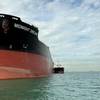Proposed 2013 VGP Links Enviro Stewardship to Long-Term Growth
The EPA’s Proposed 2013 Vessel General Permit (VGP) will require vessel owners and operators to adopt environmentally-acceptable lubricants (EALs) into their operations to further reduce their environmental impact starting in December 2013. This regulation brings a two-fold benefit to the industry by boosting the bottom line of both small and large vessel operations, while engendering positive change that ensures the preservation of ecosystems in which these vessels operate. The directives put forth in the 2013 VGP will incentivize action that is not only environmentally ethical but also can bring additional profit to the bottom line. Let’s examine the specific language of the 2013 VGP, as it relates to lubricants:
All vessels constructed on or after December 19, 2013 must use an environmentally acceptable lubricant in all oil-to-sea interfaces. “Environmentally acceptable lubricants” means lubricants that are “biodegradable” and “non-toxic” and are not “bioaccumulative.” For all vessels built before December 19, 2013, unless technically infeasible, owners/operators must use an environmentally acceptable lubricant in all oil to sea interfaces.
Who is affected by the 2013 VGP?
The wording of the 2013 VGP is purposefully broad. “Vessels,” as referenced in the 2013 VGP, covers “every description of watercraft or other artificial contrivance used as a means of transportation” on U.S. waters. The reach of the 2013 VGP spans the globe – touching any vessel owner/operator whose business depends on traveling through U.S. waters. This article will serve to detail who will be affected and how these new regulations will impact their business operations.
What will replacing conventional lubricants with EALs cost?
Every vessel that does not currently use EALs in all oil-to-water interfaces will experience incremental costs associated with phasing in environmentally-acceptable products, but in the scope of yearly vessel operations, the increase is virtually negligible. The EPA upper-bound projections estimate a 120% cost increase and their lower-bound projections estimate an increase of 50% for an average annual increase of $555 to $1,111 per vessel (see table below). Of course, depending on a vessel’s lubricant consumption rate and the type of EAL selected, costs will vary.To put these fractional cost increases into perspective, Nordic American Tankers, a major international tanker company, announced net voyage revenue per vessel per day of $16,200 in its Q2 2012 report. Using the “high-end estimate” from the EPA of the annual costs of phasing in EALs to tank barges and tank ships, it would take slightly over one hour of voyage time per vessel to recoup these costs.
Disregarding the substantial return-on-investment of using EALs in vessel operations, which this article will discuss later on, we believe the costs do not pose a threat to profitability.
What options are available with regard to EALs and how are they different?
Currently, there are four categories of EALs that vessel owners and operators can choose from:
Triglycerides
• Base Fluid: Vegetable
• Class: HETG
• Biodegradation Time: Days
• Toxicity: Low
• Typical Performance: Varies
• Seal and Hose Compatibility: Mixed
• Water Tolerance: Medium
Poly glycols (PAG)
• Base Fluid: Glycol
• Class: HEPG
• Biodegradation Time: Years
• Toxicity: High
• Typical Performance: Weak
• Seal and Hose Compatibility:
Very Poor
• Water Tolerance: Very Weak
Synthetic Esters
• Base Fluid: Synthetic
• Class: HEES
• Biodegradation Time: Days
• Toxicity: Low
• Typical Performance: Mixed
• Seal and Hose Compatibility:
Very Poor
• Water Tolerance: Very Weak
Biopolyolefins
• Base Fluid: Synthetic
• Class: HEPR
• Biodegradation Time: Days
• Toxicity: Low
• Typical Performance: Excellent
• Seal and Hose Compatibility:
Excellent
• Water Tolerance: Excellent
The EPA estimates that EALs from vegetable sources are 10 to 50% more expensive than conventional lubricants and also noted that synthetic-based lubricants tend to be significantly more expensive than mineral-based lubricants (twice to four times more expensive).
In terms of application, vegetable-based EALs demonstrate lower performance metrics and usable lifespans when compared to synthetic alternatives. Vegetable-based EALs only have an upper temperature threshold of 180°F and tend to break down when mixed with water. Perhaps most importantly, the expected change-out time for vegetable-based EALs is 1,000-2,000 hours. Biopolyolefin synthetics have an upper temperature threshold of 400°F, are water-resistant and last 10,000-15,000 hours or more. Even though synthetic products can cost up to four times more than vegetable-based products, they last ten times longer, while performing at the same level as conventional, mineral-based lubricants.
PAGs, glycol-based fluids and lubricants, tend to be highly toxic and demonstrate less effective performance than other EALs. In addition, PAGs take years to biodegrade, which this article will show makes for a poor investment compared to readily biodegradable fluids.
Overall, Biopolyolefin fluids are the optimal choice for complying with the 2013 VGP regulations, maintaining peak performance of vessel systems. In addition, these lubricants are readily biodegradable, which helps to mitigate cleanup and remediation costs following leaks and spills.
How exactly do EALs affect environmental cleanup and remediation expenditures?
Based on the low capital requirements needed to phase in EALs to oil-to-water interfaces, the use of environmentally-acceptable lubricants produce significant returns by reducing cleanup and remediation costs on fluid spills and leaks. Initial cleanup and containment efforts will always be costly to extract as much of the leaked fluid as possible. However, long-term remediation (continuing action to control lingering environmental affects like chemical toxicity and sheening) represents about 60-70 percent of spill containment costs that involve conventional lubricants and oils.
As discussed above, for a lubricant to be considered an EAL, it must be “biodegradable” and “non-toxic.” Technically, all lubricants are “inherently biodegradable,” meaning they will biodegrade eventually, but they can be toxic (like many mineral-based lubricants) and persist much longer (often years) in the environment than their readily biodegradable counterparts. Readily biodegradable lubricants meet the Organization for Economic Co-operation and Development’s (OECD) guidelines for biodegradability, breaking down at least 60% within the first 28 days and reaching the 60% level within 10 days of reaching the 10% level (10 day window criterion).
The following table shows the distinct long-term benefits of readily biodegradable products over conventional fluids.
The remediation schedule of EALs as compared to conventional lubricants is a matter of weeks versus a number of years, resulting in greatly reduced capital requirement of cleanup efforts.
What happens if a vessel owner/operator does not comply?
As with any government regulation, non-compliance will bring penalties and fines of varying amounts, depending on the severity of the case. The EPA grants enforcement authority to the United States Coast Guard (USCG), who will assist the EPA in upholding the statutes in the 2013 VGP.
Conclusion
The Proposed 2013 Vessel General Permit is an effort by the EPA to ensure the ongoing protection of the environment, while creating minimal impact on the businesses it affects. The 2013 VGP’s focus on proliferating environmentally-acceptable lubricants across the industry helps preserve fragile ecosystems in American waters and offers vessel owners and operators a significant return on a marginal upfront investment. By switching from conventional fluids to EALs, vessel operators that comply with the 2013 VGP will not only help significantly reduce their carbon footprint, but will also measurably increase profitability without sacrificing performance.
(As published in the November 2012 edition of Maritime Reporter - www.marinelink.com)













